|
|
|
Sort Order |
|
|
|
Items / Page
|
|
|
|
|
|
|
| Srl | Item |
| 1 |
ID:
104165
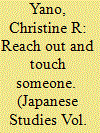

|
|
|
|
|
| Publication |
2011.
|
| Summary/Abstract |
Hello Kitty (b. 1974) in the year 2009 was all grown up. Indeed, Sanrio, the mouthless feline's maker, took the opportunity for a year-long celebration of her 35th anniversary that extended into 2010. Thirty-five: the year marks the standard end of young adult promise in Japan, after which traditionally new employment opportunities close, scholarships for post-baccalaureate education end, and fertility rates in women decline. But what does 35 years mean for a product? More specifically, what does it mean for a product that has achieved iconic status as a symbol of youthful innocence dubbed kawaii (cute) in ever-widening, global settings? Among other things, 35 years suggests the possibility of true trans-generational appeal, especially with mother-daughter pairs of Hello Kitty fans. In the case of Hello Kitty, 35 years also signals a sufficient time span from which nostalgia may be considered viable and ultimately marketable. In this paper I use Hello Kitty's 35th anniversary as a lens upon kawaii - Japanese Cute - by which we might look backward and forward to the consumer culture surrounding this now 'middle-aged' object, primarily in Japan, but extended through its global applications.
|
|
|
|
|
|
|
|
|
|
|
|
|
|
|
|
| 2 |
ID:
104169
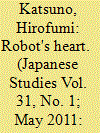

|
|
|
|
|
| Publication |
2011.
|
| Summary/Abstract |
This paper explores the processes by which humanoid robots become sites of affective investment in contemporary Japan. It particularly analyses how narratives of intimacy, conventionally found in relationships between humans, are being reproduced and embodied in interactions with humanoid robots. It uses ethnographic research on participants in Robo-One, one of Japan's most popular robotics events, to examine the development of intimate relationships between the human and the robotic, understood in terms of kokoro (loosely translated as 'heart'). The robot's heart emerges in the grey area between technological material and human imagination. Through the respective processes of tinkering and spectating, both robot builders and 'robot watchers' experience the intimacy that results from apprehending the robot's heart. This experience creates an endless hermeneutic circle, drawing together subject and object, original and copy, creator and created, and watcher and watched, to ultimately reconfigure participants' senses of their own kokoro.
|
|
|
|
|
|
|
|
|
|
|
|
|
|
|
|
| 3 |
ID:
104167


|
|
|
|
|
| Publication |
2011.
|
| Summary/Abstract |
This article explores Japanese literary engagement with the Caribbean island of Jamaica, one informed most directly by the recent popularity of Jamaican musical culture in Japan. I link these works to a discursive imagination of the international, including the Third World, as a proving ground for artistic accomplishment and for the acquisition of an ideological cosmopolitanism counterposed against life in insular Japan. This includes the discourse of jibun sagashi, or self-searching, that has emerged in the post-1991 recessionary era. I argue that a consistent trope in many works of fiction and non-fiction on Japanese travel to Jamaica is of their protagonists' or authors' intimate encounter with Afro-Jamaican blackness as both menacing and impoverished, but also vitalizing and endearing. Encountering the Afro-Jamaican, and surviving it, simultaneously affords a sense of toughness and sociopolitical enlightenment impossible elsewhere in Japan. I conclude that although these narratives usually include returns to a Japanese homeland appreciated anew, an ethnographic perspective on these issues - though not the focus of the paper - suggests that the experiences of less famous Japanese youth travelling to Jamaica might complicate these narratives offered to mainstream audiences.
|
|
|
|
|
|
|
|
|
|
|
|
|
|
|
|
| 4 |
ID:
104168
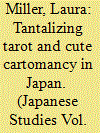

|
|
|
|
|
| Publication |
2011.
|
| Summary/Abstract |
A notable and markedly gendered development among Japanese fans of divination (uranai) and the occult is the increased desire for exotic tarot cards and other types of oracle card decks. This interest promotes new opportunities for the consumption of divination services, and fortune-telling experts offer extensive menus of card reading services in a wide range of settings. Consumers may buy beautiful, cute and novelty decks that cater to devotees of specific themes, manga, or anime, such as Hello Kitty, Evangelion, Little Twin Stars, and other adored characters. This essay understands divination cards anthropologically as a form of sensory contact between social actors that allows them to link the material world of objects with the abstract world of ideas, creating a shared universe of meaning. It looks at some of the newer forms of card divination, particularly borrowed, hybrid and reinvented practices that have emerged in recent years. I focus attention on an under-analysed girls' culture pastime that highlights the moments of physical and mental touching that transpires between tarot readers, clients and the cards themselves.
|
|
|
|
|
|
|
|
|
|
|
|
|
|
|
|
| 5 |
ID:
104163
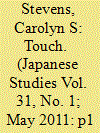

|
|
|
| 6 |
ID:
104164


|
|
|
|
|
| Publication |
2011.
|
| Summary/Abstract |
This essay explores the idea of touch as a means to think about Japanese popular culture in a transnational perspective. In the years since Appadurai coined the idea of 'scapes' of flow, we have witnessed a growing interest in phenomena associated with border crossing. As a counterpoint, I consider several examples of Japanese culture that could be seen as 'transnational flow', but provide different insights if viewed in terms of touch, encounter, and contact. In particular, I consider a Japanese rapper's dismay at the selection of his album cover as one of the worst of 2010, an American reviewer's distaste at a style of Japanese figurine production, and the integration of contemporary art exhibits in a rural island community in Japan. In each case, the moments and spaces of contact point to a way of understanding cultural influence less via the process of crossing borders than in terms of highlighting locations where cultural difference comes into contact. These examples of 'touch' also offer a way of understanding what makes fieldwork and ethnography such a useful analytical perspective for Japanese studies.
|
|
|
|
|
|
|
|
|
|
|
|
|
|
|
|
| 7 |
ID:
104166
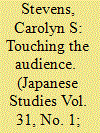

|
|
|
|
|
| Publication |
2011.
|
| Summary/Abstract |
Japanese popular music as embedded in television commercials is taken as a point of departure for understanding consumer aesthetics and practices, and how music and image can touch - or, create a lasting impression on - an audience. This phenomenon, called the tai-appu (tie-up), or an alignment between artists and products, results in an ime-ji songu (image song). These contracts between manufacturers and artist have been ubiquitous in the Japanese media landscape since the early 1980s. While tie-ups can be considered a kind of celebrity endorsement, common in many consumer cultures, they play a more prominent role in Japanese popular culture, edging out MTV-style videos as the primary method that artists use to promote their music. The success of these mini-videos can be attributed to the tie-ups' multisensory impact (with multiple images, text and sound in movement) and their overall audience accessibility. Understanding these compressed media messages is important due to recent concern about the way advertising invades, rather than enriches, the media landscape. Advertising analyses contribute to our understanding of how a society's economy and culture are inter-related; tie-ups give us particular insight into the connections between culture (music and image), economy (product popularity and sales figures) and society (audience formation and reception), and highlight the importance of sensory experience in popular culture.
|
|
|
|
|
|
|
|
|
|
|
|
|
|
|
|
|
|
|
|
|